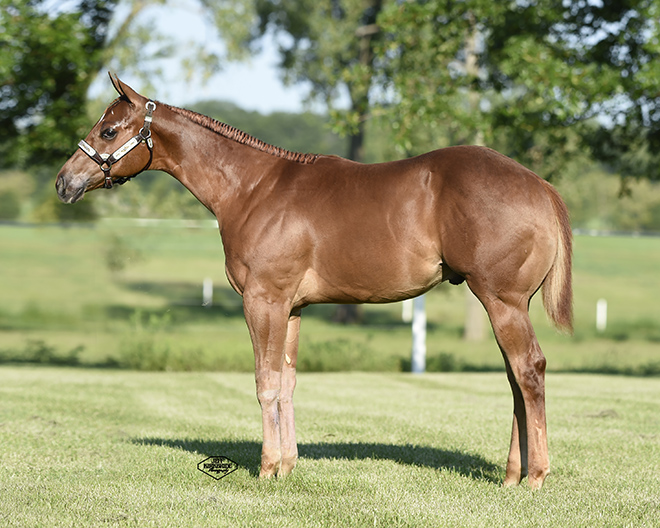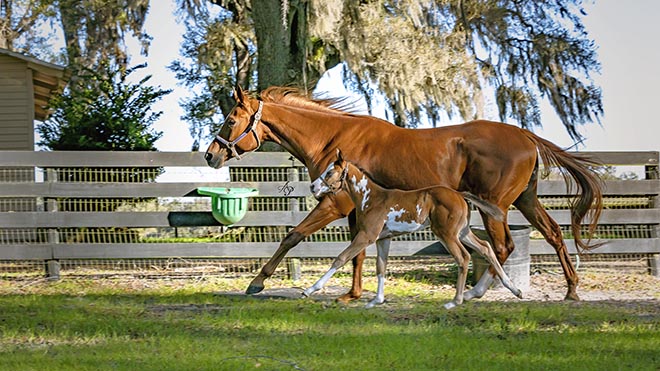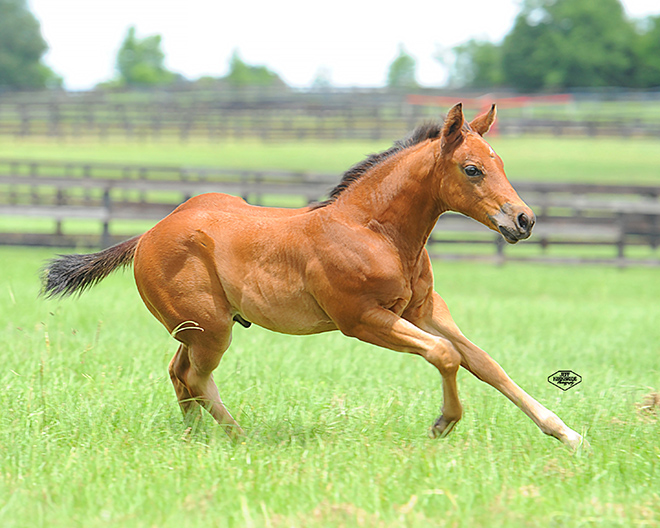
Renowned landscape photographer Ansel Adams once said, “You don’t take a good photograph, you make it.” His subjects weren’t wiggly foals, however, so making a good photo of a gangly, scampering foal can be frustrating. InStride Edition compiled a list of tips from both professional and amateur photographers to help horse owners present their little ones in the best possible way.
Jeff Kirkbride, of Ocala, Florida, makes his living taking outstanding photographs at the larger shows across the country. Kirkbride suggests keeping the sun at your back, and using a longer lens.
“Using a short lens makes their head too big and their butt look too small,” he said. “Since these babies are growing so fast, they are high in the back and low in the front, so if there is a hill for them to run up, it levels them up a little bit. Don’t exaggerate it, but a slight hill is good.”
For side shots, Kirkbride suggest standing at the hip, not the shoulder for a more pleasing angle. It is also important to see all four feet in the correct way. The two feet that are closest to the camera should be wider apart than the two feet that are farther away.

Anna Ingram, who is married to trainer Sean Knowles, works with Kathie Kennedy of Kathie Kennedy Performance Horses, taking photos and videos of horses for sale in the Ocala, Florida area. Ingram says that trying to have handlers with the foals doesn’t work. Taking photos in the early morning when the foals first go outside is good, because they are the most active then.
“I have two toddlers at home, and their attention span is about like that of a foal,” Ingram said. “You have maybe 20 minutes before that foal is going to throw their sucker in the dirt and not cooperate. Kathie and I take photos, but also make sales-prep videos. There is a small window of time where you’re going to have their attention.”
Ingram gets creative with various attention-getting items. “I’ve used umbrellas, dog toys, my kid’s toys, anything that’s different. Our kids are in the barn all the time on their Power Wheels. Since they can’t drive, they are always running into things, but the horses quickly become de-sensitized to that,” Ingram said with a laugh.
When asked about photos versus video, Ingram was quick to point out that today, many people want to see videos as well as photos.
“Photos are important, especially when considering conformation that reflects on the sire and dam, and a good photo is flattering, and has to be taken from the right angle,” she explained. “But Kathie and I are creating more and more videos so people can see how the horse moves. Back in the day, you had to mail VHS tapes to potential buyers. Videos are definitely the trend now, especially yearling videos, and there is a lot of work getting the horse show-ready, and then producing the video.”

Debbi Trubee of North Farm in North Lawrence, Ohio, takes foal pictures from the time they pop out of the oven!
“Sunshine always makes for prettier pictures and you want the sun at your back,” she said. “Bright sunshine at high noon creates horrible shadows, so I try to avoid those two things when I can. A pretty background also makes for much cleaner picture. I try to avoid having barns, houses, cars or anything that distracts from the subject of the photo. The viewer’s eye will go to the subject of the picture rather than all the clutter in the background.”
Trubee agrees with Kirkbride and Ingram about the importance of the correct angle. Positioning yourself across from the foal’s hip bone makes a better angle for keeping them in proportion. Paying attention to where their feet are is also a key component of a great photo; they shouldn’t have their feet too far under their body, or be stretched out.
“Patience goes a long way here,” Trubee explained. “You just have to wait until they’ve moved to a more desirable position.”
Sometimes it pays to think outside the box.
“Another element of a great foal shot is stooping down to their level, and having the baby standing either on level ground or a bit uphill,” Trubee said. “Remember that the object closest to the camera will appear the biggest, so if the baby swings their head around to look at you and you snap the picture, the baby’s head is going to look huge. That’s not a pretty sight!”
And good equipment helps, but that can also include a wide range of arsenal.
“I have a Nikon D810 that I shoot with but I also use my I-phone quite often, since these newer phones have great cameras,” Trubee said.
Becky Bailey, of Batavia, Ohio, also recommends getting down to a foal’s level for the best photos.
“If you’re up high, their heads look enormous.”
And in this case, don’t be afraid to splurge.
“Take a ton of photos,” Bailey advises. “With digital, it doesn’t matter how many you take; just keep on shooting. I use a zoom lens, because they’ll act better if I’m farther away. I take a stool or a three-step ladder so I don’t have to sit in wet grass, and wait for them to get done nursing. Early morning or late afternoon has the best light, and I keep the sun behind me.

Bailey admits, getting the perfect shot is not easy.
“Roans are especially difficult, they never look clean and shiny, you have to get them at just right time of day,” she said. “Other things that are pretty standard for all horse photographs are not putting their feet in a hole, or have them standing too far uphill so their back looks artificially high. Ears forward is tough to get, but having someone make a commotion far away, like drive a golf cart back and forth, may work.”
One thing that Bailey is particular about is not having manure in the photos. If the photo session is where horses have been milling about, either clean the area first, or Photoshop the manure out.
“It’s difficult to have great backgrounds sometimes with foal photos,” she said. “Early in the year, there isn’t green grass. One of our clients always waits until there is grass to take photos to send to me, but if you’re good with Photoshop, you can put grass in. As far as trying to handle the foals for a shot, you can try to have someone hold them, or hold the mare, but then the foal dances around, and you have people in the photo. Once we were trying to get nice shots on a lawn, and a foal got so mad at us that he went backwards into the pond! We quit trying to do it that way.”
Bailey often kills two birds with one stone by taking a lot of photos from all sides, so that the photos can be used for registration as well. She also waits a week or two after foaling so that the foals have fluffed out.
“Three months is a good age, they are big and strong before weaning,” she said. “After weaning, they don’t look as good. I wait for them to pop back before I take any more photos.”
Bailey said all of this is often easier said than done.
“I’m giving advice, and I don’t always follow it all,” she said. “But I think it’s important to keep all of the photos organized. I’ve had times where I’m trying to find photos of a foal that I raised, and couldn’t find them very easily. We’re in our seventeenth foal crop, so now, I organize them by year, and within that year, by what mare they’re out of. From those photos, I take the ones that are the best for registration, and keep those in a separate folder. One thing that I have stopped doing is keeping them all, there are just too many.”
Bailey stands One Hot Krymsun, and says, “As a stallion owner, I also keep photos that people have sent me. One very difficult aspect of being a stallion owner and trying to take photos is that you’re tired. Breeding, foaling, being up at all hours, you just don’t get out with a camera as often as you’d like to. I do have a phone in my pocket, but there’s no depth if you’re taking them far away. You can take good pictures up close with a phone, and I’m going to look into getting a lens for the phone camera.”

Stallion owner and photographer Sarah Rosciti, of North Sctuate, Rhode Island, has become quite adept at taking photos, and turned her hobby into a business called SR Images. Her clients include Machine Made, Hot N Blazing, multiple clients of Pat Odell Performance Horses, Taylor Kungle, and Falls Creek Farm to name a few. Rosciti’s photography career began with a camera that her mother-in-law bought for Rosciti’s husband. Standing a stallion for the first time, 3-year-old Easy On The Eyez, Rosciti understands the importance of only putting the best pictures online.
“Once those photos are out there, you can’t take them back. I spend hours taking photos of our foals,” she said. “It usually takes quite a few snaps to get ‘the’ shot I’m after. Sometimes the foals cooperate, and sometimes they want to pretend they are California Chrome. I really like to capture shots with the mare and foal, because I think people really connect with those.”
Whether you use your phone or a sophisticated camera, good photography is critical for showing your stallion, broodmare, and their progeny at their best.



You must be logged in to post a comment Login